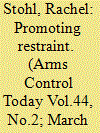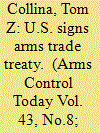|
|
|
Sort Order |
|
|
|
Items / Page
|
|
|
|
|
|
|
| Srl | Item |
| 1 |
ID:
129105


|
|
|
|
|
| Publication |
2014.
|
| Summary/Abstract |
On January 15, 2014, the United States released a document describing its new policy governing transfers of conventional weapons. The policy revision was long overdue, as the new publicly released document, Presidential Policy Directive 27 (PPD-27),[1] replaced a classified directive that came out in 1995.[2] The world has changed dramatically since the end of the Cold War. Until the release of the new policy document, however, the United States had been using policy guidance rooted in the geopolitical challenges created by the fall of the Soviet Union in making its arms transfer decisions and in outlining policy priorities and approaches to the global arms trade. According to a White House summary, a multi-year interval review of U.S. arms export policy "concluded that the 1995 conventional arms transfer policy was effective but needed to be updated to address 21st century national security and foreign policy objectives."[3] Thus, the new U.S. policy more accurately reflects the reality of U.S. arms transfers today. The Obama administration began its review when it came into office, but U.S. officials have said the impetus to finish the review came from events during the Arab Spring, when canisters of tear gas emblazoned with "Made in the USA" dominated pictures of the uprisings in Cairo's Tahrir Square. Questions surrounding U.S. arms sales to Egypt and other Arab countries led to increased scrutiny over the process of determining whether to transfer conventional arms and whether arms sales in fact led to U.S. influence over the recipient.
|
|
|
|
|
|
|
|
|
|
|
|
|
|
|
|
| 2 |
ID:
128086


|
|
|
|
|
| Publication |
2013.
|
| Summary/Abstract |
The United States and 17 other countries signed the Arms Trade Treaty (ATT) on Sept. 25, pushing the number of signatories to the pact, which was opened for signature June 3, to 107.
Calling it a significant step toward controlling the illicit trade in conventional weapons, Secretary of State John Kerry signed the treaty on behalf of the United States, the world's largest arms exporter, in a ceremony at the United Nations. "This is about keeping weapons out of the hands of terrorists and rogue actors," Kerry said.
"It's significant that the United States, which [accounts] for about 80 percent of the world's export in arms, has signed," Australian Foreign Minister Julie Bishop told a news conference. In 2012, states engaged in arms transfers totaling more than $85 billion, not including black market transfers, according to the Congressional Research Service.
|
|
|
|
|
|
|
|
|
|
|
|
|
|
|
|
|
|
|
|
|